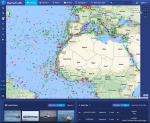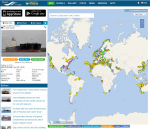
Tracking - Marine
Ship tracking apps are used to monitor the position and movement of ships in real-time, primarily in the maritime sector. Here's a list of the typical information these apps collect.
Location Data. GPS coordinates of the ship, providing real-time tracking of the position.
Route Information. Details on the current route of the ship, including past trajectories.
Ship Identification. Details such as the name of the ship, type, flag, and IMO (International Maritime Organization) number.
Voyage Status. Information on the voyage status, such as destination, estimated time of arrival, and current status.
AIS (Automatic Identification System) Data. Information transmitted via the AIS system, which includes type of ship, cargo, dimensions, and other technical specifications.
Weather and Sea Conditions. Information on weather and sea conditions along the ship's route.
Navigation Logs. Detailed logging of the ship's movements and activities.
Alerts and Notifications. Alerts on specific events, such as the approach of other ships, adverse weather conditions, or changes in course.
Port Data. Information on departure and arrival ports, including dock and terminal details.
Compliance Data. Information relevant to regulatory compliance, such as maritime traffic control zones and environmental restrictions.











